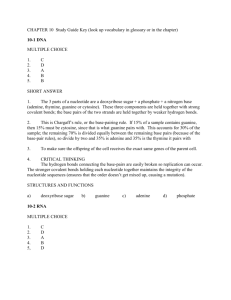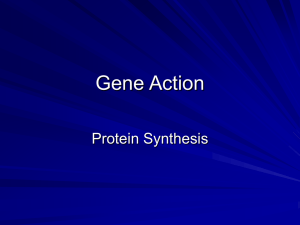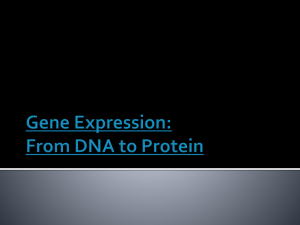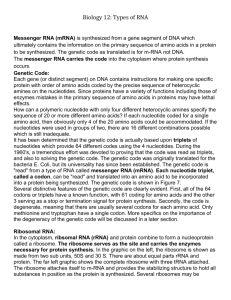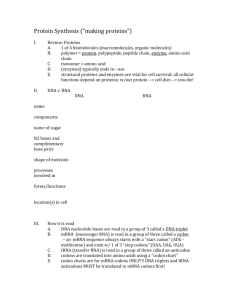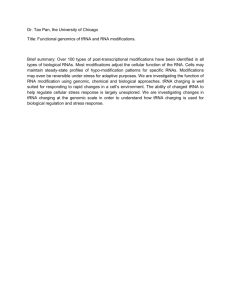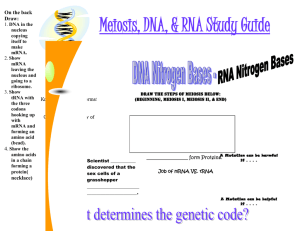IB Biology Protein Synthesis Madden/Van Roekel Transcription
advertisement
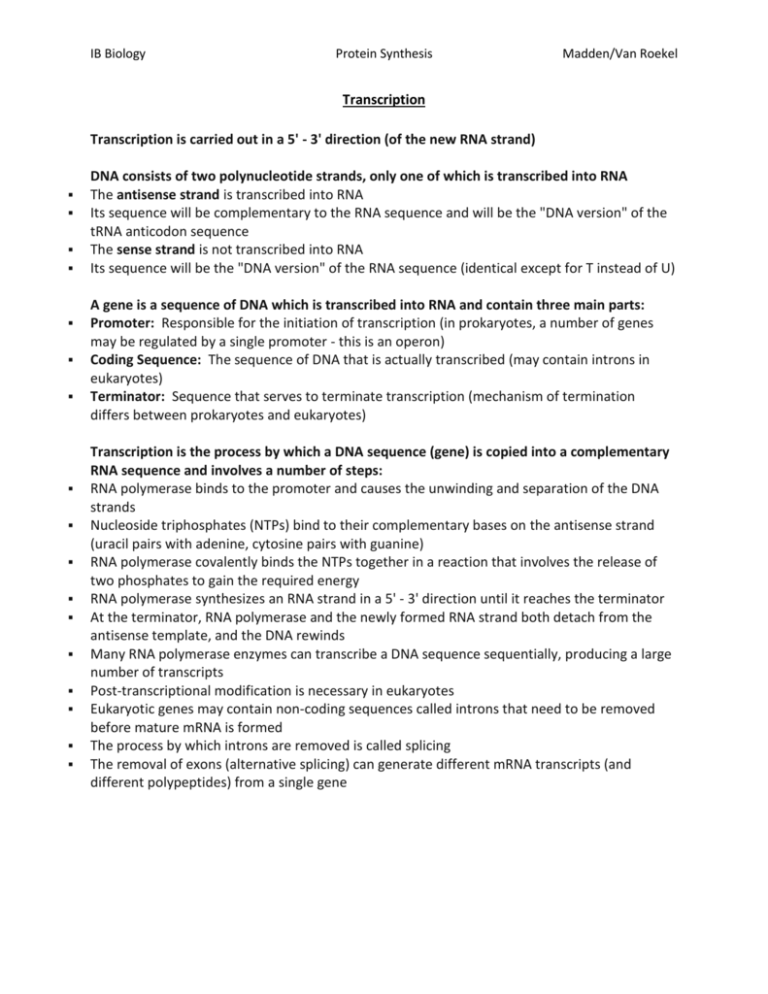
IB Biology Protein Synthesis Madden/Van Roekel Transcription Transcription is carried out in a 5' - 3' direction (of the new RNA strand) DNA consists of two polynucleotide strands, only one of which is transcribed into RNA The antisense strand is transcribed into RNA Its sequence will be complementary to the RNA sequence and will be the "DNA version" of the tRNA anticodon sequence The sense strand is not transcribed into RNA Its sequence will be the "DNA version" of the RNA sequence (identical except for T instead of U) A gene is a sequence of DNA which is transcribed into RNA and contain three main parts: Promoter: Responsible for the initiation of transcription (in prokaryotes, a number of genes may be regulated by a single promoter - this is an operon) Coding Sequence: The sequence of DNA that is actually transcribed (may contain introns in eukaryotes) Terminator: Sequence that serves to terminate transcription (mechanism of termination differs between prokaryotes and eukaryotes) Transcription is the process by which a DNA sequence (gene) is copied into a complementary RNA sequence and involves a number of steps: RNA polymerase binds to the promoter and causes the unwinding and separation of the DNA strands Nucleoside triphosphates (NTPs) bind to their complementary bases on the antisense strand (uracil pairs with adenine, cytosine pairs with guanine) RNA polymerase covalently binds the NTPs together in a reaction that involves the release of two phosphates to gain the required energy RNA polymerase synthesizes an RNA strand in a 5' - 3' direction until it reaches the terminator At the terminator, RNA polymerase and the newly formed RNA strand both detach from the antisense template, and the DNA rewinds Many RNA polymerase enzymes can transcribe a DNA sequence sequentially, producing a large number of transcripts Post-transcriptional modification is necessary in eukaryotes Eukaryotic genes may contain non-coding sequences called introns that need to be removed before mature mRNA is formed The process by which introns are removed is called splicing The removal of exons (alternative splicing) can generate different mRNA transcripts (and different polypeptides) from a single gene IB Biology Protein Synthesis Madden/Van Roekel Overview of Transcription Translation tRNA Molecules Each different tRNA molecule has a unique shape and chemical composition that is recognised by a specific tRNA-activating enzyme The enzyme (aminoacyl-tRNA synthetase) first binds the amino acid to a molecule of ATP (to form an amino acid-AMP complex linked by a high energy bond) The amino acid is then transferred to the 3'-end of the appropriate tRNA, attaching to a terminal CCA sequence on the acceptor stem and releasing the AMP molecule The tRNA molecule with an amino acid attached is thus said to be 'charged' and is now capable of participating in translation The energy in the bond linking the tRNA molecule to the amino acid will be used in translation to form a peptide bond between adjacent amino acids Ribosome Structure Ribosomes are made of protein (for stability) and ribosomal RNA (rRNA - for catalytic activity) They consist of two subunits: The small subunit contains an mRNA binding site IB Biology Protein Synthesis Madden/Van Roekel The large subunit contains three tRNA binding sites - an aminacyl (A) site, a peptidyl (P) site and an exit (E) site Ribosomes can be either found freely in the cytosol or bound to the rough ER (in eukaryotes) Ribosomes differ in size in eukaryotes and prokaryotes (eukaryotes = 80S ; prokaryotes = 70S) Ribosomes floating freely in the cytosol produce proteins for use within the cell Ribosomes attached to the rough ER are primarily involved in producing proteins to be exported from the cell or used in the lysosome These proteins contain a signal recognition peptide on their nascent polypeptide chains which direct the associated ribosome to the rough ER Translation occurs in four main steps: The start codon (AUG) is located at the 5' end of the mRNA sequence and the ribosome moves along it in the 3' direction Hence translation occurs in a 5' - 3' direction Initiation: Involves the assembly of an active ribosomal complex Elongation: New amino acids are brought to the ribosome according to the codon sequence Translocation: Amino acids are translocated to a growing polypeptide chain Termination: At certain "stop" codons, translation is ended and the polypeptide is released Pre-Initiation: Specific tRNA-activating enzymes catalyse the attachment of amino acids to tRNA molecules, using ATP for energy Initiation: The small ribosomal subunit binds to the 5' end of mRNA and moves along it until it reaches the start codon (AUG) Next, the appropriate tRNA molecule binds to the codon via its anticodon (according to complementary base pairing) Finally, the large ribosomal subunit aligns itself to the tRNA molecule at its P-site and forms a complex with the small ribosomal subunit Elongation: A second tRNA molecule pairs with the next codon in the ribosomal A-site The amino acid in the P-site is covalently attached via a peptide bond to the amino acid in the A-site IB Biology Protein Synthesis Madden/Van Roekel Translocation: The ribosome moves along one codon position, the deacylated tRNA moves into the E-site and is released, while the tRNA bearing the dipeptide moves into the P-site Another tRNA molecules attaches to the next codon in the newly emptied A-site and the process is repeated The ribosome moves along the mRNA sequence in a 5' - 3' direction, synthesising a polypeptide chain Multiple ribosomes can translate a single mRNA sequence simultaneously (forming polysomes) Termination: Elongation and translocation continue until the ribosome reaches a stop codon These codons do not code for any amino acids and instead signal for translation to stop The polypeptide is released and the ribosome disassembles back into subunits The polypeptide may undergo post-translational modification prior to becoming a functional protein Overview of the Process of Translation
